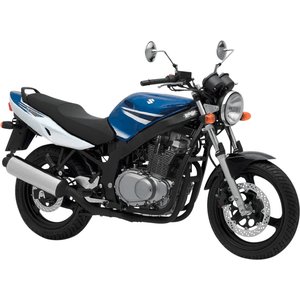Suzuki GS 500 E (1989–2000): A Timeless Workhorse for Riders Who Value Simplicity
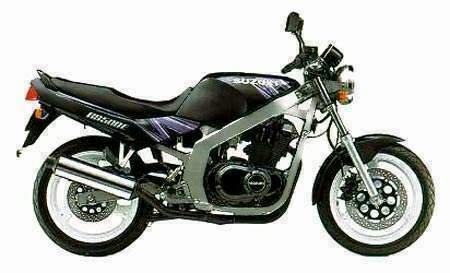
Introduction
The Suzuki GS 500 E is a motorcycle that defies the passage of time. Produced from 1989 to 2000, this air-cooled parallel twin has earned a reputation as a forgiving, reliable, and endlessly practical machine. While it won’t set your hair on fire with blistering speed, it’s a bike that rewards riders with honest mechanics, approachable handling, and a character that feels refreshingly human in an era of increasingly complex motorcycles. After spending a week with a well-maintained 1997 model, it’s clear why this Suzuki remains a favorite for commuters, training schools, and riders who value substance over spectacle.
Engine and Performance: Air-Cooled Charm
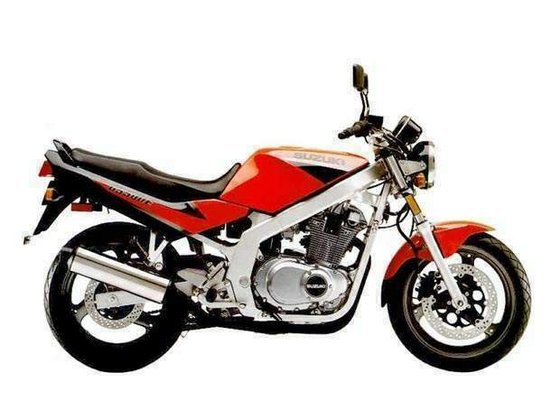
At the heart of the GS 500 E lies a 487cc, air-cooled, DOHC parallel-twin engine. With a bore and stroke of 74mm x 56.6mm (2.9” x 2.2”), it’s a design that prioritizes durability over cutting-edge innovation. The 2-valve-per-cylinder configuration and twin Mikuni BST33 carburetors deliver a linear powerband, producing 45–47 HP (33–34 kW) at 9,200 RPM and 39–40 Nm (28.8–29.5 lb-ft) of torque peaking around 7,400 RPM.
Twist the throttle, and the GS doesn’t explode forward—it builds. The engine thrives between 4,000–8,000 RPM, offering a satisfying growl through its pea-shooter exhaust. Acceleration is adequate rather than thrilling: 0–100 km/h (0–62 mph) takes about 5.9 seconds, while the quarter-mile passes in 15.3 seconds at 138 km/h (85.7 mph). Top speed hovers around 170 km/h (105 mph), though sustaining 130–140 km/h (80–87 mph) on highways feels more natural.
What it lacks in outright power, it makes up in mechanical empathy. The air-cooled design avoids radiator complexities, and the 6-speed transmission shifts with a satisfying, old-school clunk. Fuel consumption averages 4.5–5.2 L/100 km (45–52 MPG), making it frugal for daily rides.
Handling: Predictable, Precise, and Forgiving
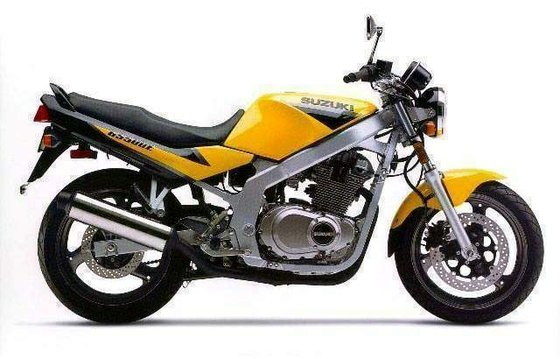
The GS 500 E’s steel twin-spar frame and 37mm telescopic forks (with 120mm/4.7” of travel) provide a handling profile that’s neutral and confidence-inspiring. Weighing 169–171 kg (373–377 lbs) dry, it’s light enough for urban filtering yet stable at speed. The 1410mm (55.5”) wheelbase and 25-degree rake strike a balance between agility and straight-line composure.
Push it into corners, and the GS responds with eager compliance. The Bridgestone Exedra G550 tires (110/70-17 front, 130/70-17 rear) offer decent grip, though upgrading to modern rubber unlocks hidden potential. Braking is handled by single 310mm front and 250mm rear discs—adequate for the bike’s weight, but requiring a firm squeeze during aggressive riding.
Where the GS truly shines is in low-speed maneuverability. The 790mm (31.1”) seat height and narrow profile make it accessible for shorter riders, while the upright riding position ensures all-day comfort.
Design and Practicality: Function Over Fashion
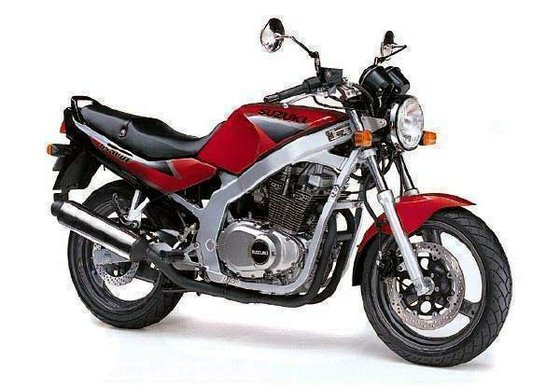
The GS 500 E’s styling is unapologetically utilitarian. The round headlight, analog gauges, and unfaired design scream “motorcycle” in its purest form. Yet there’s a timelessness to its simplicity—a quality that aging examples wear gracefully.
Practical touches abound:
- 17L (4.5-gallon) fuel tank: Provides 300–350 km (186–217 mi) between fill-ups.
- Center stand: Makes chain maintenance and parking effortless.
- Dual-seat design: Accommodates a passenger without sacrificing rider comfort.
While the thin seat padding becomes noticeable after two hours, it’s a small trade-off for a bike that prioritizes durability. The exposed engine and steel frame also make DIY repairs straightforward—a rarity in modern machinery.
Competition: How the GS 500 E Stacks Up
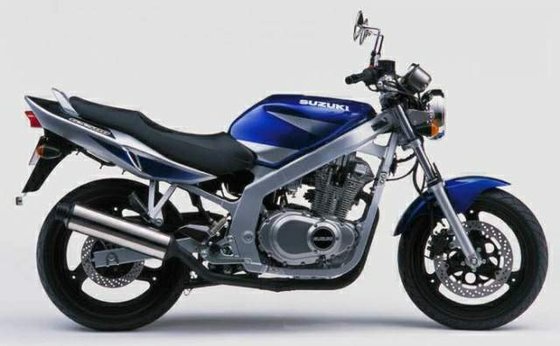
In the 1990s, the GS 500 E faced fierce rivals. Here’s how it compares:
1. Kawasaki EX500 (Ninja 500R)
- Pros: Liquid-cooled engine, 64 HP, sportier ergonomics.
- Cons: Higher maintenance costs, less comfortable for commuting.
- Verdict: The EX500 outpaces the GS on power but feels more clinical.
2. Honda CB500
- Pros: Smoother inline-twin engine, better wind protection.
- Cons: Heavier (183 kg/403 lbs), less responsive throttle.
- Verdict: The CB500 is a better tourer, but the GS is nimbler in traffic.
3. Yamaha Seca II
- Pros: 600cc engine, 72 HP, sharper styling.
- Cons: Complex carburetion, higher seat height (805mm/31.7”).
- Verdict: The Seca II caters to sportier riders; the GS appeals to pragmatists.
GS 500 E’s Edge: Lower running costs, simpler maintenance, and a chassis that forgives novice mistakes. While it trails in horsepower, its accessibility keeps it relevant in used markets.
Maintenance: Keeping the GS 500 E Thriving
The GS 500 E is a mechanic’s dream—if you follow these key points:
1. Valve Adjustments
- Interval: Every 6,000 km (3,700 mi).
- Specs: Intake/Exhaust clearance: 0.03–0.08mm (0.0012–0.0031”).
- Upgrade Tip: Swap stock adjusters for MOTOPARTS.store’s threaded valve tappets for precision.
2. Oil Changes
- Interval: Every 3,000 km (1,860 mi).
- Capacity: 2.6L (2.75 qt) without filter; 2.9L (3.06 qt) with filter.
- Recommendation: MOTOPARTS.store’s synthetic blend SAE 10W-40 improves cold starts.
3. Carburetor Tuning
- Pilot Screw Setting: 2.0–2.5 turns out.
- Jet Kit: MOTOPARTS.store’s Stage 1 kit optimizes mid-range throttle response.
4. Chain Care
- 110-link chain: Lubricate every 500 km (310 mi).
- Sprockets: Replace stock 16T/39T with MOTOPARTS.store’s steel set for longevity.
5. Brake Upgrades
- Pads: Organic compound pads reduce rotor wear.
- Fluid: DOT 4 flush every 2 years.
Conclusion: The GS 500 E’s Enduring Legacy
The Suzuki GS 500 E isn’t about chasing specs—it’s about the joy of riding without pretense. Its air-cooled twin thrums with mechanical honesty, its chassis forgives misjudged corners, and its design invites tinkering rather than dealership visits. For riders seeking a dependable daily companion or a blank canvas for customization, the GS 500 E remains a compelling choice.
At MOTOPARTS.store, we celebrate motorcycles like this—machines that thrive with thoughtful upgrades. Whether you’re refreshing suspension, upgrading brakes, or simply maintaining its original charm, we’ve got the parts to keep your GS 500 E running for another 30 years.
Ride simple. Ride often.
Specifications sheet
| Engine | |
|---|---|
| Stroke: | Four-stroke |
| Max power: | 34 kW | 46.0 hp |
| Max torque: | 39 Nm |
| Fuel system: | 2 x 33mm Mikuni BST carburetors |
| Max power @: | 9200 rpm |
| Displacement: | 487 ccm |
| Max torque @: | 7600 rpm |
| Configuration: | Parallel |
| Cooling system: | Air-cooled |
| Compression ratio: | 9.0:1 |
| Number of cylinders: | 2 |
| Valves per cylinder: | 2 |
| Dimensions | |
|---|---|
| Wheelbase: | 1410 mm (55.5 in) |
| Dry weight: | 169 |
| Wet weight: | 182 |
| Seat height: | 790 mm (31.1 in) |
| Overall width: | 800 mm (31.5 in) |
| Overall height: | 1060 mm (41.7 in) |
| Overall length: | 2080 mm (81.9 in) |
| Ground clearance: | 120 mm (4.7 in) |
| Fuel tank capacity: | 17 L (4.5 US gal) |
| Drivetrain | |
|---|---|
| Final drive: | chain |
| Chain length: | 110 |
| Transmission: | 6-speed |
| Rear sprocket: | 39 |
| Front sprocket: | 16 |
| Maintenance | |
|---|---|
| Engine oil: | 10W40 |
| Idle speed: | 1200 ± 100 rpm |
| Brake fluid: | DOT 4 |
| Spark plugs: | NGK DPR8EA-9 or NGK DPR8EIX-9 |
| Spark plug gap: | 0.9 |
| Forks oil capacity: | 0.764 |
| Engine oil capacity: | 2.9 |
| Engine oil change interval: | Every 5000 km or 2 years |
| Valve clearance (intake, cold): | 0.03–0.08 mm |
| Valve clearance check interval: | 24,000 km (15,000 mi) |
| Valve clearance (exhaust, cold): | 0.03–0.08 mm |
| Recommended tire pressure (rear): | 2.5 bar (36 psi) solo, 2.8 bar (41 psi) with passenger |
| Recommended tire pressure (front): | 2.25 bar (33 psi) |
| Chassis and Suspension | |
|---|---|
| Frame: | Steel twin-spar |
| Rear tire: | 130/70-17 |
| Front tire: | 110/70-17 |
| Rear brakes: | Single 250 mm disc, 2-piston caliper |
| Front brakes: | Single 310 mm disc, 2-piston caliper |
| Rear suspension: | Rising rate monoshock, 7-way preload adjustment |
| Front suspension: | Telescopic forks, 7-way preload adjustment |
| Rear wheel travel: | 115 mm (4.5 in) |
| Front wheel travel: | 120 mm (4.7 in) |



